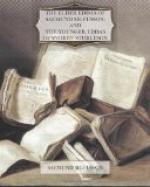YLG, the Howling; to howl.
YMIR, a confused noise, like the rustling of trees when shaken by the wind; also the clang of metals.
SIEGFRIED AWAKENS BRYNHILD.
(after the painting of R. Bung.)
The story of Siegfried and Byrnhild constitutes the greatest epic in Teutonic Gothic literature. Its origin is hard to trace, but parts of the legends carry the investigator back to Iranian sources. Its greatest development, however, may justly be credited to Icelandic sagas, in which the mythology of the Norse people has a prominent place. In both the Gothic and Teutonic versions, while considerable variation of incident is noticeable, the awakening of Brynhild, a valkyrie maiden, and daughter of Wotan, is represented as having been accomplished by Siegfried, who rides through a wall of flames which surrounds her, and thus breaks the spell which binds her to sleep until a warrior fearless enough to brave fire shall come to claim her for a bride.
[Illustration]
A FEAST IN VALHALLA.
(From a painting by Jno. Kellar.)
An admirable description of a feast of the gods, in Valhalla, will be found on pages 293-94-95 of this volume. It was a strong belief among the Goths, prior to the introduction of Christianity among them, that the bodies of all warriors who met their deaths in battle were transported directly to Valhalla by Valkyrie maidens on the backs of winged horses. Upon reaching this mythological heaven the dead were revived and ever thereafter enjoyed drinking mead, eating swine flesh, and in fighting their battles over again every day.
[Illustration]
THE DEATH OF ATLI.
(From a painting by S. Goldberg.)
Atli has been identified as Attila, called in history “the Scourge of God,” a king of the Huns who twice defeated the Romans under Theodosius, and plundered the eternal city itself. He was guilty of many excesses and is reported to have died of a hemorrhage on the day following his marriage with Ildico (453). In the story of Seigfried and Brynhild, however, he is represented as having married Gudran, daughter of Grimhild and King Giuki, who it will be recalled by readers of the other volumes of this series, beguiled Siegfried by means of a magic potion, into marriage with her. Her feelings revolted against an alliance with Atli, but she accepted him for a husband in order thereby to obtain the power to gratify her vengeance against Hogni (Hagan), who had assassinated Siegfried.
[Illustration]



